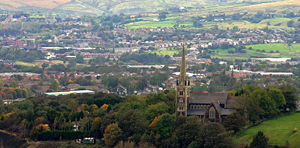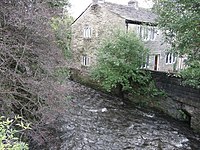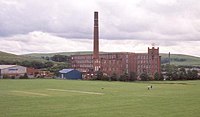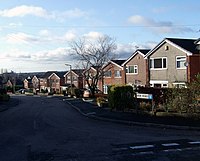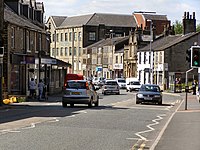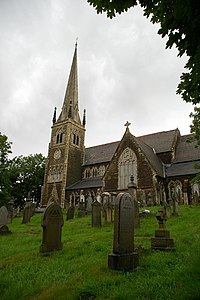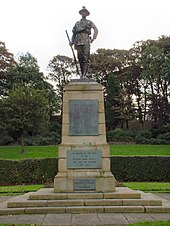Milnrow
| Milnrow | |
| Lancashire | |
|---|---|
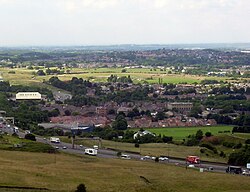 Milnrow and the M62 | |
| Location | |
| Grid reference: | SD926126 |
| Location: | 53°36’36"N, 2°6’40"W |
| Data | |
| Population: | 13,061 (2011) |
| Post town: | Rochdale |
| Postcode: | OL16 |
| Dialling code: | 01706 |
| Local Government | |
| Council: | Rochdale |
| Parliamentary constituency: |
Rochdale |
Milnrow is a suburban town in Lancashire. It stands beside the River Beal at the foothills of the South Pennines, and forms a continuous urban area with Rochdale. Milnrow is two miles east of Rochdale's town centre and ten miles north of the City of Manchester.
The town reaches from the wild countryside at the foot of Windy Hill in the east to the urban, industrial lands by the Rochdale Canal in the west, and its townscape has swallowed the villages of Tunshill and Newhey. It is adjacent to junction 21 of the M62 motorway.
During the Middle Ages, Milnrow was a hamlet in the Parish of Rochdale. After the Norman conquest, it was owned by minor families, such as the Schofields and Cleggs. In the 15th century, the descendants of these families successfully agitated for a chapel of ease to be constructed in Milnrow by the banks of the River Beal, triggering its development as the main settlement in Butterworth. Despite this distinction, Milnrow did not increase much further in size or population until the dawn of the woollen trade in the Late Middle Ages.
To supplement their income, the inhabitants of Milnrow entered the domestic system, producing flannel and woollen cloth in purpose-built weavers' cottages, some of which have survived from the Early Modern period and are now listed buildings.[1] Coalmining and metalworking also flourished in this period, but the Industrial Revolution supplanted the domestic industries and converted Milnrow into an urban mill town that mass-produced textile goods in cotton mills, such as Ellenroad Ring Mill (now a museum).
Milnrow has been described as "the centre of the south Lancashire dialect".[2] John Collier (who wrote under the pseudonym of Tim Bobbin) was an acclaimed 18th-century caricaturist and satirical poet from Milnrow who wrote in a broad Lancashire dialect. Rochdale-born poet Edwin Waugh was influenced by Collier's work, and wrote an extensive account of Milnrow during the mid-19th century in a tribute to Collier.[3] Although Milnrow's heavy textile industries declined during the mid-20th century, the town has continued to grow as a result of suburbanisation, urban renewal and its immediate proximity to road, rail and motorway networks.
Contents
Geography
Milnrow stands roughly 830 feet above sea level, on the western slopes of the Pennines, ten miles north-northeast of Manchester city centre, in the valley of the River Beal. Blackstone Edge and the West Riding of Yorkshire are to the east; Rochdale and Shaw and Crompton are to the west and south respectively.
The River Beal, a tributary of the River Roch, runs centrally through Milnrow from the south through Newhey. The soil is light gravel and clay, with subsoil of rough gravel,[4] and the local geology is carboniferous coal measures. The town rises to the Pennine moorland, by the upland Piethorne Valley and close to Windy Hill. From this point the average height of the land falls gradually towards the direction of Rochdale to the northwest, into a mixture of undulating farmland and suburbia.[5][6]
In 1855, the poet Edwin Waugh said of Milnow:
Milnrow lies on the ground not unlike a tall tree laid lengthwise, in a valley, by a riverside. At the bridge, its roots spread themselves in clots and fibrous shoots, in all directions; while the almost branchless trunk runs up, with a little bend, above half a mile towards Oldham, where it again spreads itself out in an umbrageous way.[3]—Edwin Waugh, Sketches of Lancashire life and localities (1855)
There are a number of small named-places in and around Milnrow, including Clegg, Firgrove, Gallows, Haugh, Newhey, Kitcliffe, Ogden, and Tunshill. Newhey, at the south of Milnrow and separate villages such as Shaw and Crompton. The Gallows public house is said to occupy the land of an ancient execution site; Gallows, a former hamlet at northeastern Milnrow, is named in reference to a baronial gallows.[7][8] Kitcliffe, Ogden and Tunshill, to the east of central Milnrow, are hamlets that occupy the upper, mid and lower Piethorne Valley respectively.
History
Neolithic stone axe have been found at Hollingworth.[9] Bronze and Iron Age peoples left thousands of flint tools which have been found on the moorland surrounding Milnrow, including a stone hammer found at Low Hill in 1879.[10] Low Hill was the site of an ancient burial mound where a funerary urn was found. A small Roman statue of the goddess Victory was discovered at Tunshill Farm in 1793.[11] During excavations at Piethorne Reservoir in the mid-18th century, an Iron Age Celtic spear-head with a 5-inch blade was unearthed.[12]
Inscribed stones discovered in 1986 at Lowhouse Farm, one of which has Latin text, suggest the existence of a 9th-century Anglo-monastic site, or of a Viking-Age literate community from Milnrow, Rochdale or the surrounding region.[13]
The name 'Milnrow' appears to be derived from Old English, but its origin and meaning have not been deciphered with any certainty. The name may be a corruption of an old pronunciation of "Millner Howe", a water driven corn mill at a place called Mill Hill on the River Beal that was mentioned in deeds dating from 1568.[14][15] Another explanation is that it means a "mill with a row of houses", combining the Old English elements myne and raw. Others have suggested that the name "Milnrow" is derived from a local family with the surname Milne, who owned a row of houses in the locality. A map from 1292 shows "Milnehouses" at Milnrow's present location, other spellings have included "Mylnerowe" (1545) and "Milneraw" (1577).[14][15]
Milnrow emerged as a settlement after the Norman conquest of 1066; the Norman families of "de Butterworths", "de Turnaghs", "de Schofields", "de Birchinleghs", "de Wylds" and "Cleggs" controlled the lands which formed the township of Butterworth from which Milnrow evolved as its main settlement.[14][16] In addition to the chapelry of Milnrow, Butterworth encompassed the hamlets of Clegg, Wildhouse, Belfield, Butterworth Hall, Lowhouse, Newhey, Ogden, Tunshill, Haughs, and Bleaked-gate-cum-Roughbank.[17] Butterworth was linked, ecclesiastically, with the parish of Rochdale.
During the Middle Ages, the small, scattered community in and around Milnrow was primarily agrarian, with the growing and milling of grain and cereal being the main labour of the people.[7] Dry ironstone smelting was introduced into Milnrow at a very early time as evidenced from ancient kilns found at Tunshill.[7] A chantry was constructed in the year 1400 by the Byrons—the then Lords of the Manor—and a chapel for the wider community in 1496;[18][19] A document dated 20 March 1496, during the reign of Henry VII, proclaims that open land by the River Beal would be the site of the new chapel.[19]
Legal documents dated 1624 state that Milnrow consisted of six cottages; there were a further nine at Butterworth Hall, and three at Ogden.[20] Milnrow did not expand until the introduction of a woollen weaving trade which began in the Late Middle Ages and continued until the 19th century.[21][5] During this time nearby Rochdale—the local market town—was used as a central marketing, finishing and fellmongering hub.[21] The handloom weaving of woollen cloth and flannels in the domestic system became the staple industry of Milnrow, facilitating the community's growth and prosperity.[22] Between 40,000 and 50,000 sheep skins were needed every week to provide for Milnrow's industries,[23] and as early as the 16th century, the demand for wool was so great it had outstripped the local supply of the region and had to be imported from Ireland and the Midlands. As a consequence of the woollen trade, rows of "fine stone domestic workshops" or weavers' cottages were constructed beyond Milnrow's original core, with dwelling quarters on the lower floors and loom-shops on the top floor.[24]
With the onset of the Industrial Revolution, the River Beal was used to power large weaving mills.[5] Within one generation during the late-19th century,[5] and following a boom in nearby Oldham, Milnrow's staple industry changed from wool weaving to cotton spinning.[5][25] Soon, distinctive rectangular brick-built mills dominated Milnrow's landscape.[26] Milnrow, the location of some of the earliest ring spinning companies, had many of the characteristics of a company town. The Heaps of Milnrow exercised significant deferential and political influence in the local area.[27]
Following the Great Depression, the region's textile sector experienced a decline until its eventual demise in the mid-20th century. Milnrow's last cotton mill was Butterworth Hall Mill, demolished in the late 1990s.[28] Milnrow experienced population growth and suburbanisation in the second half of the 20th century, spurred by the construction of the M62 motorway through the area, putting the village a commutable distance from Manchester and the cities of the West Riding of Yorkshire. Milnrow Metrolink station opened as part of the Metrolink light-rail network on 28 February 2013.[29]
Economy
Before late-20th century deindustrialisation, Milnrow's economy was linked closely with a spinning and weaving tradition which had evolved from developments in textile manufacture during the Industrial Revolution. Industries ancillary to textile production were also operational, such as coal mining at Tunshill, and metalworking at Butterworth Hall.[30] Butterworth Hall Colliery was the largest colliery in the Rochdale region, employing around 300 men in 1912.[31]
Modern sectors in the area include engineering, packaging materials, the dyeing and finishing of textiles and carpets, and ink production.[32] The main street comprises a variety of shops, restaurants and food outlets.
The biggest employers are Holroyd Machine Tools, part of Precision Technologies Group who have been based in the town since they moved from Manchester to Milnrow in 1896.[33] In the early 20th century they operated a foundry in Whitehall Street and employed engineers and apprentices.[33] As of 2006 Holroyd had a workforce of 160, but its parent company Renold PLC employs a further 200 people at a base in there.[34][35][36] Global industrial and consumer packaging company Sonoco operate a warehouse in the town.[37]
Over half-a-million units of local delicacy Rag Pudding are mass-produced by Jackson's Farm Fayre in their Milnrow factory.[38]
In Newhey, Sun Chemical produce printer inks and supplies,[39] and Newhey Carpets design and produce carpets.[40] At Ogden, textiles are dyed and finished by PW Greenhalgh.[41]
A new 420-acre Kingsway Business Park is being developed between Milnrow and Rochdale, by junction 21 of the M62 motorway.
Sights abou the town
The Grade II listed Church of St James, Milnrow's parish church, was built in 1869 and is dedicated to St James the Apostle.[42] It is part of the Church of England, within the Diocese of Manchester.[43] The origins of the church can be traced to a chantry built by the Byrons in the year 1400. When that baronial family moved from Milnrow to another of their homes following the Wars of the Roses, the local population was left without a place of worship and a chapel was constructed by the River Beal to serve this community.[19] This structure existed until the 1790s, when a "poorly designed" chapel was erected and consecrated; however, due to structural weaknesses, that church was demolished in 1814.[19] Following an interim period when a "plain building" was used for worship, the present church building was built and consecrated by the Bishop of Manchester on 21 August 1869.[44]
Described as "by far the most distinctive and splendid building in the district",[44] the neo-Gothic Newhey, St Thomas parish church was built in 1876 and served a new Anglican parish of Newhey created in the same year.[45][46] The church was extensively damaged in an arson attack on 21 December 2007.[47]
Milnrow War Memorial is located in Memorial Park at Newhey, and is a Grade II listed structure.[48] The memorial was originally sited in central Milnrow, set back from the road near Milnrow Bridge, and was unveiled on 3 August 1924 by Major General A. Solly-Flood, a former commander of 42nd (East Lancashire) Division. The memorial is constructed of sandstone surmounted by a bronze statue of a First World War infantry soldier with rifle and fixed bayonet symbolic of the young manhood of the district in the early days of First World War.
Clegg Hall is a 17th-century hall and Grade II* listed building situated in green space between Milnrow, Rochdale and Littleborough.[49][50] It was built in about 1610 for Theophilus Aston and may have been built on the site of a mediæval house and inn.[49]
In Newhey is the Ellenroad Steam Museum, the retained engine house, boiler house, chimney and steam engine of Ellenroad Mill, a former 1892-built cotton mill designed by Sir Philip Stott, 1st Baronet. Now operated as an industrial heritage centre, the mill itself is no longer standing, but the steam engine (the world's largest working steam mill engine)[51] is maintained and steamed once a month by the Ellenroad Trust.[52] The museum has the only fully working cotton mill engine with its original steam-raising plant in the world.[53] Ellenroad Mill produced fine cotton yarn using mule spinning.[51]
Hollingworth Lake lies beyond Milnrow, by Littleborough and is part of a local country park. It was built in 1801 as a feeder reservoir for the Rochdale Canal, but it soon became a tourist destination for local people during their leisure time.[54] The lake covers an area of 130 acres and the path around it originally measured two and a half miles.
Sport
- Cricket: Milnrow C.C., founded in 1892.[55]
- Rugby: New Milnrow and Newhey Rugby League Club
The Soccer Village consists of four indoor pitches in an arena with grandstand spectator seating for 300.[56] It is used for casual, amateur and organised leagues and tournaments.
Outside links
| ("Wikimedia Commons" has material about Milnrow) |
- Ellenroad Engine House
- milnrow.com
- The United Co-op Milnrow Band
- link4life.org: history of Milnrow and Newhey
References
- ↑ Frangopulo (1977), p. 149.
- ↑ Joyce (1993), p. 198.
- ↑ 3.0 3.1 Waugh, Edwin (1855). Sketches of Lancashire life and localities. James Galt. p. 61.
- ↑ A History of the County of Lancaster - Volume pp 213–222: {{{2}}} (Victoria County History)
- ↑ 5.0 5.1 5.2 5.3 5.4 Rochdale Metropolitan Borough Council 1985, p. 33.
- ↑ Hignett (1991), p. 7.
- ↑ 7.0 7.1 7.2 Hignett (1991), p. 3.
- ↑ Lewis (1848), pp. 729–733.
- ↑ National Monuments Record: No. 45988 – Neolithic finds
- ↑ Poole, S. (1986). "A Late Mesolithic and Early Bronze Age Site at Piethorn Brook, Milnrow". Greater Manchester Archaeological Journal 2: 11–30.
- ↑ National Monuments Record: No. 46071 – Victoria statue from Tunshill Farm
- ↑ Bateson 1949, p. 3
- ↑ Oakden, Vanessa (2012). "A Pre-Conquest Latin Inscription from North-West England". http://www.academia.edu/9425015/A_PRE-CONQUEST_LATIN_INSCRIPTION_FROM_NORTH-WEST_ENGLAND.
- ↑ 14.0 14.1 14.2 Hignett (1991), p. 2.
- ↑ 15.0 15.1 Ekwall (1972), p. 56.
- ↑ Manchester City Council. "Rochdale Towns". spinningtheweb.org.uk. http://www.spinningtheweb.org.uk/m_display.php?irn=240&sub=nwcotton&theme=places&crumb=Rochdale. Retrieved 20 April 2008.
- ↑ "Descriptive Gazetteer entry for Butterworth". visionofbritain.org.uk. http://www.visionofbritain.org.uk/descriptions/entry_page.jsp?text_id=845610&word=NULL. Retrieved 22 April 2008.
- ↑ Rochdale Boroughwide Cultural Trust. "Events in Milnrow 1400–1929!". link4link.org. http://www.link4life.org/index.cfm?fuseaction=c.showPage&pageID=1064. Retrieved 22 April 2008.
- ↑ 19.0 19.1 19.2 19.3 Hignett (1991), p. 32.
- ↑ Fishwick 1889, p. 122.
- ↑ 21.0 21.1 McNeil, R. & Nevell, M. (2000), p. 35.
- ↑ Fishwick 1889, p. 54.
- ↑ Hignett (1991), p. 10.
- ↑ Frangopulo (1977), p. 29.
- ↑ Hignett (1991), p. 11.
- ↑ Sellers (1991), p. 47.
- ↑ "Industrial Relations and Technical Change: Profits, Wages and Costs in the Lancashire Cotton Industry, 1880–1914" (PDF). eprints.whiterose.ac.uk. 2000. http://eprints.whiterose.ac.uk/1449/1/tomss4_Steve_doc_2_final.pdf. Retrieved 29 April 2008.
- ↑ "This is Milnrow: Industry". milnrow-village.freeserve.co.uk. http://www.milnrow-village.freeserve.co.uk/milnrow1.htm. Retrieved 18 June 2008.
- ↑ "Rochdale extension to Metrolink tram network opens". bbc.co.uk. 28 February 2013. http://www.bbc.co.uk/news/uk-england-manchester-21612322. Retrieved 2 March 2013.
- ↑ Godman 1996, p. 63.
- ↑ Godman 1996, p. 59.
- ↑ Rochdale Boroughwide Cultural Trust. "Milnrow & Newhey". link4life.org. http://www.link4life.org/index.cfm?fuseaction=c.showPage&pageID=925. Retrieved 10 June 2008.
- ↑ 33.0 33.1 Godman 1996, p. 62.
- ↑ Foster, Stephen (4 July 2006). "Buyers are all set to move in on company". rochdaleobserver.co.uk. http://www.rochdaleobserver.co.uk/news/s/514/514817_buyers_are_all_set_to_move_in_on_company.html. Retrieved 22 April 2008.
- ↑ Anon (20 March 2006). "In gear for good news story still on the run". rochdaleobserver.co.uk. Archived from the original on 28 August 2008. https://web.archive.org/web/20080828113848/http://www.rochdaleobserver.co.uk/community/rochdale_150/work/s/510/510701_in_gear_for_good_news_story_still_on_the_run.html. Retrieved 22 April 2008.
- ↑ "Renold Gears, Rochdale". renold.com. 2004. http://www.renold.com/Company/Addresses/UnitedKingdom4.asp. Retrieved 29 April 2003.
- ↑ Sonoco Products. "Sonoco Locations". sonoco.com. http://www.sonoco.com/SonocoLocations/SearchEngine.asp. Retrieved 22 April 2008.
- ↑ Foster, Stephen (28 April 2007). "Rag trades 'puds' tapas to shame". Manchester Evening News. menmedia.co.uk. http://menmedia.co.uk/rochdaleobserver/news/s/527090_rag_trades_puds_tapas_to_shame. Retrieved 17 December 2012.
- ↑ "Printers Services & Supplies in Rochdale". rochdaleonline.co.uk. http://www.rochdaleonline.co.uk/business/P/612/printers-services-and-supplies. Retrieved 17 December 2012.
- ↑ "Newhey Carpets". newheycarpets.co.uk. About; and Contact Us. http://www.newheycarpets.co.uk/. Retrieved 24 December 2012.
- ↑ "Contact Us". pwgreenhalgh.com. http://www.pwgreenhalgh.com/contact_us.html. Retrieved 24 December 2012.
- ↑ National Heritage List 11244596: Church of Saint James, Milnrow
- ↑ "Milnrow, Saint James". manchester.anglican.org. http://www.manchester.anglican.org/churches_detail.asp?ID=319. Retrieved 22 April 2008.
- ↑ 44.0 44.1 Hignett, (1991), p. 33.
- ↑ "A vision of Newhey EP". visionofbritain.org.uk. http://www.visionofbritain.org.uk/unit_page.jsp?u_id=10355187&c_id=. Retrieved 2 May 2008.
- ↑ Townships – Butterworth
- ↑ "Church hit by fire". rochdaleobserver.co.uk. 24 December 2007. http://www.rochdaleobserver.co.uk/news/s/1029652_church_hit_by_fire. Retrieved 10 June 2008.
- ↑ National Heritage List 1162572: Milnrow War Memorial
- ↑ 49.0 49.1 National Monuments Record: No. 46049 – Clegg Hall
- ↑ National Heritage List 1309615: Clegg Hall
- ↑ 51.0 51.1 "Ellenroad Steam Museum". industrialpowerhouse.co.uk. Archived from the original on 27 September 2007. https://web.archive.org/web/20070927192155/http://www.industrialpowerhouse.co.uk/attractiondetail.asp?id=39. Retrieved 1 May 2008.
- ↑ McNeil, R. & Nevell, M. (2000), p. 39.
- ↑ "Welcome to Ellenroad!". ellenroad.org.uk. http://ellenroad.org.uk/. Retrieved 1 May 2008.
- ↑ "Hollingworth Lake". link4life.org. http://www.link4life.org/index.cfm?fuseaction=c.showPage&pageID=621. Retrieved 1 May 2008.
- ↑ "150 Years of History". milnrowcc.com. http://www.milnrowcc.com/History.html. Retrieved 2 May 2008.
- ↑ "Welcome to The Soccer Village Website". soccervillage.net. http://www.soccervillage.net/. Retrieved 2 May 2008.
- Ekwall, Eilert (1972) [1922]. The place-names of Lancashire. E.P. Publishing. ISBN 0-85409-823-2.
- Fishwick, Henry (1889). The History of the Parish of Rochdale in the County of Lancaster. James Clegg.
- Frangopulo, N. J. (1977). Tradition in Action: The Historical Evolution of the Greater Manchester County. Wakefield: EP Publishing. ISBN 0-7158-1203-3.
- Godman, Pam (1996). Rochdale: Pocket Images. NPI Media Group. ISBN 978-0-7524-0382-3.
- Hignett, Tim (1991). Milnrow & Newhey: A Lancashire Legacy. Littleborough: George Kelsall Publishing. ISBN 0-946571-19-8.
- Joyce, Patrick (1993). Visions of the People: Industrial England and the Question of Class, c.1848–1914. Cambridge University Press. ISBN 978-0-521-44797-3.
- Lewis, Samuel (1848). A Topographical Dictionary of England. Institute of Historical Research. ISBN 978-0-8063-1508-9.
- McNeil, R. & Nevell, M (2000). A Guide to the Industrial Archaeology of Greater Manchester. Association for Industrial Archaeology. ISBN 0-9528930-3-7.
- Sellers, Gladys (1991). Walking the South Pennines. Cicerone Press. ISBN 978-1-85284-041-9.
